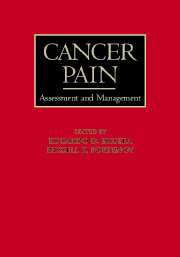Book contents
- Frontmatter
- Contents
- List of contributors
- Preface
- SECTION I MECHANISMS AND EPIDEMIOLOGY
- SECTION II ASSESSMENT AND SYNDROMES
- SECTION III PHARMACOLOGICAL TREATMENT
- SECTION IV NONPHARMACOLOGICAL APPROACHES
- 12 Anesthesiological procedures
- 13 Psychological interventions
- 14 Rehabilitation medicine interventions
- 15 Neurosurgical techniques in the management of cancer pain
- SECTION V THE ROLE OF ANTINEOPLASTIC THERAPIES IN PAIN CONTROL
- SECTION VI PAIN IN SPECIAL POPULATIONS
- SECTION VII DIFFICULT PAIN PROBLEMS
- SECTION VIII SPECIAL TOPICS
- Index
12 - Anesthesiological procedures
from SECTION IV - NONPHARMACOLOGICAL APPROACHES
Published online by Cambridge University Press: 08 October 2009
- Frontmatter
- Contents
- List of contributors
- Preface
- SECTION I MECHANISMS AND EPIDEMIOLOGY
- SECTION II ASSESSMENT AND SYNDROMES
- SECTION III PHARMACOLOGICAL TREATMENT
- SECTION IV NONPHARMACOLOGICAL APPROACHES
- 12 Anesthesiological procedures
- 13 Psychological interventions
- 14 Rehabilitation medicine interventions
- 15 Neurosurgical techniques in the management of cancer pain
- SECTION V THE ROLE OF ANTINEOPLASTIC THERAPIES IN PAIN CONTROL
- SECTION VI PAIN IN SPECIAL POPULATIONS
- SECTION VII DIFFICULT PAIN PROBLEMS
- SECTION VIII SPECIAL TOPICS
- Index
Summary
Introduction
Improvements in the understanding of the pathophysiology of pain, increased availability of pharmacological agents, adoption of different modes of drug administration, and development of comprehensive multidisciplinary care have all contributed to increasing the number of patients with effective control of cancer pain. The Guidelines for Cancer Pain Relief established by the World Health Organization (1) have been useful in emphasizing the effectiveness of oral morphine as a mainstay of cancer pain treatment. Although the analgesic “ladder” drew attention to the importance of using opioids of increasing potency and adding adjuvant therapies as necessary (2), the strategy today is to tailor the ingredients of a multimodal oral regimen to each patient's requirements at a particular stage of the disease. However, 10%–20% of patients will require more intensive measures to control pain, particularly in the terminal phases of their illness. Treatment options include primary therapies such as radiotherapy, chemotherapy, and surgery to reduce pain in specific cases; parenteral or spinal administration of analgesic agents; neurolytic blocks; and surgical neuroablative procedures. In a prospective study of 2118 patients with cancer pain managed according to WHO Guidelines, anesthetic nerve blocks were performed in 8% of patients, neurolytic nerve blocks in 3%, and spinal analgesic administration (epidural and intrathecal) in 3% of patients (2). The true incidence of patients requiring interventional analgesic techniques remains unknown, as the size of the group from which patients in reported series are selected is unknown, and inclusion criteria for spinal therapies or nerve blocks vary in different centers according to local experience, expertise, and referral patterns.
- Type
- Chapter
- Information
- Cancer PainAssessment and Management, pp. 201 - 227Publisher: Cambridge University PressPrint publication year: 2003
- 1
- Cited by

